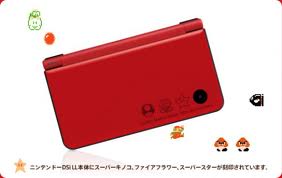|
Nintendo DSi XL (Nintendo DSi LL in Japan) is the successor to the Nintendo DSi. It has new features such as a 4.2" screen, improved battery life and a new Touch Pen. It was released in Japan on November 21, 2009. Its successor was Nintendo 3DS.
Hardware
The Nintendo DSi XL features 4.2 inch screens, much larger than the current model and comes with a longer stylus and a new Touch Pen. However, it has the same resolution as the DSi screen. The Nintendo DSi XL's battery, depending on the screen's brightness, lasts 1–3 hours longer than the standard Nintendo DSi. The console will come loaded with three DSiWare games including Brain Age Express: Arts & Letters, Brain Age Express: Math, and Photo Clock. In Japan, it comes with three different DSiWare games including A Bit of Brain Training: Arts, A Bit of Brain Training: Science, and Kiyou Akira Rakuhiku Language Easier (Dictionary).
Technical specifications
| CPU | Two ARM architecture CPUs, ARM7 and ARM9. |
| Size when closed | 161 mm. long, 91.4 mm. wide, 21.2 mm. tall |
| Top screen | 3.36 inches long, 2.52 inches wide. |
| Bottom screen | 3.36 inches long, 2.52 inches wide. |
| Pixels | 256 * 192 (49,152) per screen. |
| Weight | 314 grams |
| Colors | 260,000 colors can be produced by the Nintendo DSi XL. |
| Sound | Stereo sound. There are two speakers on the top portion of the handheld. A headphone jack is on the side of the bottom portion. |
| Wi-Fi | 802.11b/g wireless. |
| Storage | The system can store 256 MB, though SD Cards can provide more space, up to a maximum of 32 GB with SDHC Cards. |
| RAM | 16 MB |
| Battery | A 1050 mAH battery that lasts 4 to 17 hours depending on various factors including the light settings and how many times the player has charged the system. After around 500 charges the battery may have to be replaced.[1] |
| Media | DS game cards, SD cards (32 GB and under). |
| Camera | Two .3 megapixel cameras. |
Development, history and sales
The Nintendo DSi XL was developed by Nintendo Research and Engineering in Kyoto, Japan. Masato Kuwahara was the project leader, while other prominent members included Kazuo Yoneyama, who provided a large amount of support to the designers, Masaki Amano, the mechanical designer, and Takaki Fujino, the designer (it was Fujino's first time as a system designer, though he had been with Nintendo for seven years). Three people were responsible for the planning of the Nintendo DSi XL, which each one assigned to a certain part of the system. Amano, for example, was responsible for the upper screen.
While the Nintendo DSi XL is an enhanced Nintendo DSi, Nintendo Research and Engineering initially planned to develop a larger DS Lite, and even created a prototype mold for the system. This enlarged DS Lite was in development during 2007, though because of the increased demand for not only the Wii but the then-current DS Lite model, Nintendo president Satoru Iwata made the decision not to take the development any further. After the idea for an enlarged DS Lite system was put on the shelf for later, Nintendo began development on the Nintendo DSi. During this time period, the designers at Nintendo R&E had already made the decision to develop a larger version of the DSi after they were finished. Iwata told the employees to develop both a large and small DSi, but because it wouldn't be reasonable to work on them both at the same time, they would have to work on them separately. Kuwahara is quoted saying that working on both pieces of hardware at the same time would have been "absolutely impossible".
Kuwahara has stated that Yoneyama was a great support to him and the development team. Yoneyama assisted Nintendo by going to China for a long period of time to help those at the Chinese Nintendo factory. Kuwahara mentioned that he felt slightly bad for sending Yoneyama off because of his age, saying that he was "a little concerned about his health". Yoneyama, who was in China prior to the initial stages of the DSi XL development, stated that the team back in Japan sent him a crudely drawn image of the DSi XL which he described as a "really bad drawing". Around this point in time, Yoneyama discovered that developing a system with 4.2 inch screens would be feasible for Nintendo, which was a concern around the company. The same designs that the team created would move on to Fujino, who would be asked to create a proper design of the handheld.
After months of rumors over a new DSi, on October 29, Nintendo Japan announced a new kind of DSi. Its main new feature is the new large 4.2" screen design. Afterwards Nintendo announced the console will be coming to Europe March 5 [1] and in America [2] on March 28 with the name Nintendo DSi XL. In Japan, the Nintendo DSi XL sold 103,524 units in its first two days. To compare, the DS Lite sold 67,653 units and the PSP Go sold 28,275. The Nintendo DSi, on the other hand, sold 170,779 units while the original Nintendo DS sold 441,485 units.
Colors and Themes

There have been many different colors and themes of the Nintendo DSi XL. The most commonly sold and the the first to come out were blue, red, and black. There was also a red DSi XL with Mario franchise characters on it sold for the 25th anniversary of the Mario franchise. There are many other themes created by various companies and other video game franchises.
References
- ↑ Cite error: Invalid
<ref>tag; no text was provided for refs namedspecs
